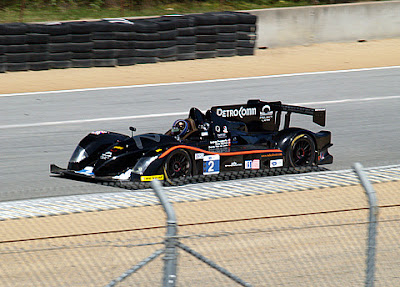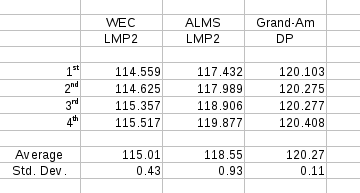This year was the first (and last) year that the Grand-Am Rolex series ran at Road Atlanta and this offers a final opportunity to compare the DP to the LMP2 lap times prior to performance balancing that will place those two different cars in the same class next year. Here are the raw numbers for the top 4 fastest race laps in each class.
It must be remembered that the DP teams had no previous track data to work with.Grand-Am ran in April, ALMS ran in October.
It will be interesting to see what sort of numbers are put up next year after TUSC/IMSA "balance" the performance of these cars.Speaking of which, TUSC/IMSA has finally released the essential elements of that balancing of LMP2 and DP cars competing in next year's Prototype class. I read about it at Racer.com.
The important changes to the DP cars are:
- New mandatory front diffuser and rear wing
- Brake materials are now open
- Single piece forged wheels are now allowed
- Differential choice is now open
- Damper choice is now less restricted
- Throttle actuation is now free
- Engines will gain about 50hp
The important changes to the LMP2 cars are:
- Le Mans aero kits mandated for Elkhart Lake, Daytona and Indy
- Minimum weight will increase from 900kg to 960kg
- Spec. Continental tires are mandatory
- Driver teams can be any mix of Pro and Am
The DP cars will be faster, at some significant up-front cost. Some DP teams are whining about the cost of these changes, but it is worth noting that only the new aero pieces are mandatory (approx. $15K). So if economy is more important that winning, they don't need to spend the money.If they don't want to upgrade, they will find it hard, not only to keep up with LMP2 cars and with upgraded DPs, but with LMPC cars as well. The current LMPC cars are faster than the current DP cars (the #8 LMPC's fastest race lap at Road Atlanta was 1:16.0). I would love to see one of the top teams from Grand-Am switch to and LMP2 car next year. Imagine: Gnassi dropping the BMW V8 from the DP car into an LMP2 chassis (Oreca, Lola/Multimatic, Adess, Riley).How about putting the Ford EcoBoost V6, like the one in Michael Shank's new DP, into an LMP2 chassis? That Roush engine was developed for LMP2 after all. Here is a rare photo of that engine in the Libra Radical/Ford at the 2012 Laguna Seca ALMS round:
The LMP2 cars will be slower. The mandatory aero changes for LMP2 run about $13.7K.The biggest hit will be the added 60kg (132lbs.). This increase will have a negative affect not only on acceleration, but braking, manuverability, fuel economy and reliability. The evolution of the LMP2 class has seen weight go from 675kg to 700, to 750, to 800, to 820, to 900, and now to 960kg. While this penalty will allow the DPs to compete, to me it is exactly the wrong thing to do. Road cars are getting lighter with smaller engines, why are we making race cars artifically heavier (other than politics)? I have had my say about this in an earlier posting.
When it comes time to formulate new specs for the Prototype class for TUSC (2017?), I am hoping for a true lightweight, efficient formula that takes advantage of modern automotive technology and keeps the flavor of sophisticated racing that the old ALMS series promoted alive.



